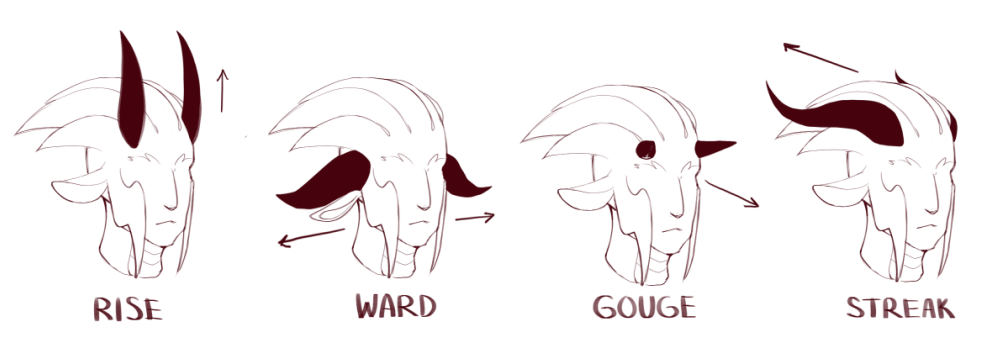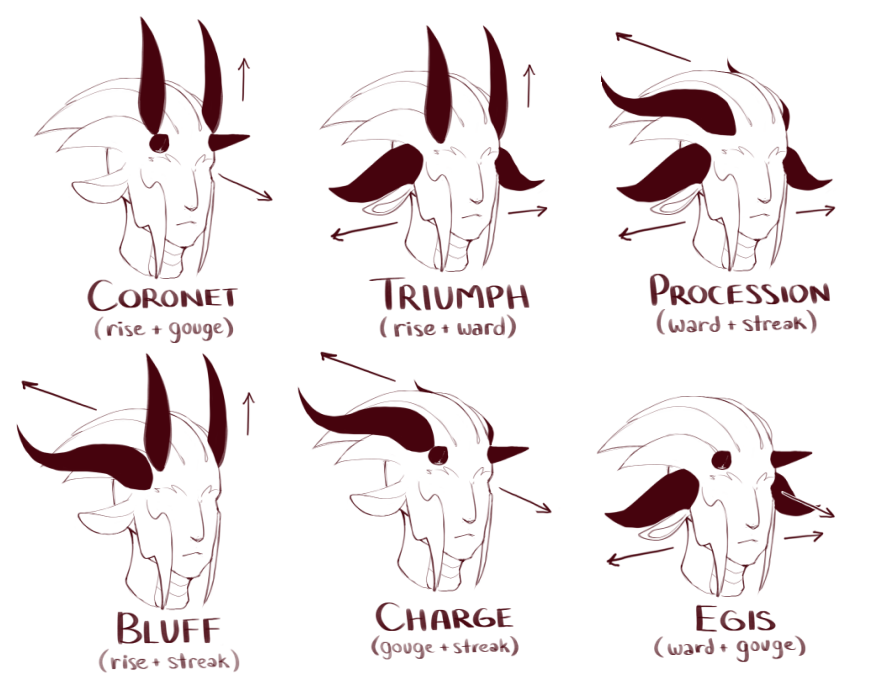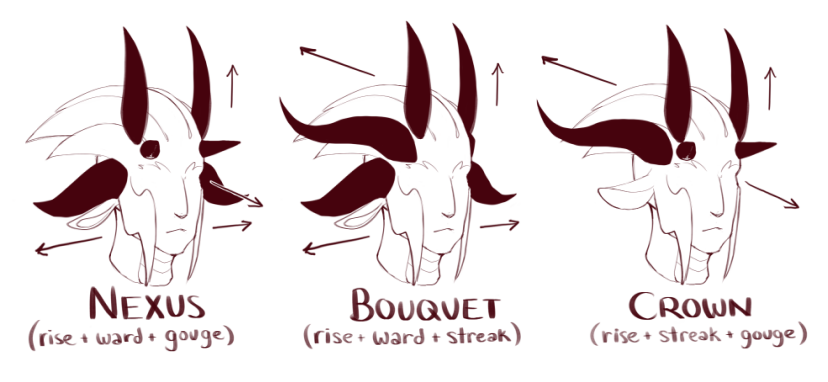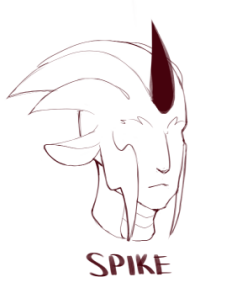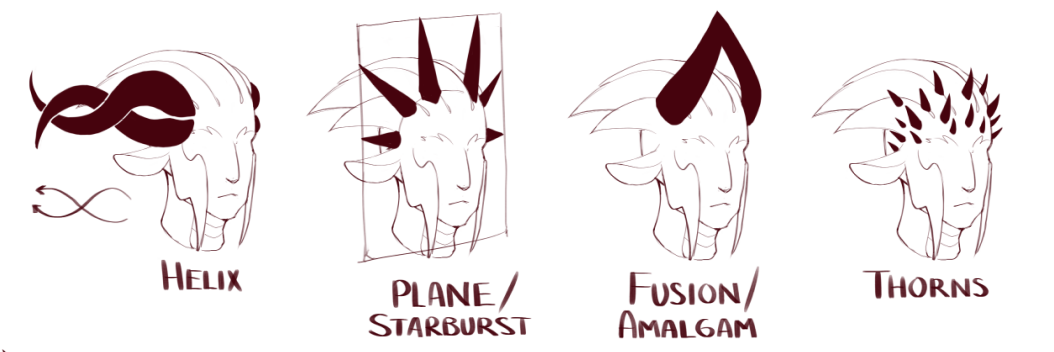Culture
Ferah-saar are social creatures that often forge social bonds with one another, leading to the creation of complex societies throughout the planet. They are also prolific tool users, which is often cited as the reason as to why they have emerged as the dominant species of Myr'seros.
There are four major subcultures within the larger Ferah-saar culture, roughly coinciding with the four major biospheres on Myr'seros: Vaelyr'saar (highlands of the Zyrsitian Peaks), Saaxhei'saar (mountainous coastal regions like the Kyr'xhaer Fjords and the Shattered Coast), Maatsen'saar (low-lying areas of the Xhei Lowlands), and Leyvahc'saar (the various islands of the Sea of Secrets, including the Faetahran Islands).
Communication
Ferah-saar speak a common language (Ferah'yhuh) composed of sharp consonants and hisses; Ferah'yhuh once had thousands of local dialects, but now only a few dozen major and minor dialects remain.
In addition to verbal communication, Ferah-saar also engage in a variety of non-verbal communications, particularly with the mandibles, tail, and ears. Mandibles are highly involved in facial expressions – those without mandibles, either due to genetics or accidental (and sometimes, purposeful) removals, are often perceived as dull and unemotional by others. Mandibleless Ferah-saar are also considered less trustworthy, as they have less tells when lying.
Society
Historically, Ferah-saar lived in medium-sized colony groups of approximately 100-200 individuals. Each colony had its own territory, which may contain one or more residential areas called "siirahcs". Siirahcs vary in layout and appearance, but all contain three crucial components: a communal area for summer usage, an outdoor nest site where eggs may overwinter, and an area dedicated for hibernal dens. Dens are not individually or family owned. Each siirahc's den area has pre-dug hibernal dens of varying sizes, which can be claimed for use during the early fall depending on the needs of the families in the colony. Claims are re-evaluated each fall and re-distributed accordingly; families may or may not get the same den as they had the previous year.
Nowadays, most Ferah-saar live in large cities with thousands of individuals. In these cities, Ferah-saar will often create pseudo-colonies with the other individuals living in their buildings. Rooms are shared amongst residents and distributed based on need. Rent does not go towards a particular room, but to the building as a whole. There are dedicated free-of-charge outdoor facilities are available to hold overwintering eggs. There are also indoor holding facilities that artificially chill the building to the required temperatures to ensure each egg can hatch, but these facilities typically have high rental fees and are only used by the richest of the Ferah-saar.
Clothing and Accessories
Adult Ferah-saar generally do not wear clothes, as their insulating fur and scales serve to protect them from the cold. However, juveniles are more susceptible to the cold, especially after hatching, so family members or close relatives will produce blankets and cloaks by felting their shed winter coats. Excess hair may also be used to make accessories. Accessories are usually hung off or tied to the horns, mandibles, ears, elbow protrusions, or ankle protrusions, and are used as a way of visual communication.
Courtship
Attractiveness in Ferah-saar is based mainly on horn appearance, and to a lesser extent, coat appearance and scale appearance. Highly-valued traits include: complex, undamaged horns; smooth, glossy coats; and symmetrical scales. Certain rare recessive traits, such as having 4 toes per foot and multiple pupils per eye, are also deemed highly attractive.
Since all individuals are capable of mating with one another, Ferah-saar will choose their partners based solely on appearance and personality. Competition for mates is relatively low, as most Ferah-saar will have multiple partners and children by multiple individuals. However, the picking and choosing of which mates get to become parents is much more complicated.
Strong self-incompability genes make it impossible for closely-related individuals to have children. As such, it is important for Ferah-saar to know who their close relatives are for family-planning purposes. Due to how families may be composed of both related and unrelated Ferah-saar, extensive ancestry records must be kept in order to ascertain which individuals are too closely related to have children. Parents will give copies of their genealogy records to their children once they are old enough to understand its importance. In the modern era, this has largely been replaced by digital recordkeeping apps.
The presence of such strong self-incompatibility genes has also led to the absence of a cultural stigma against incest. Ferah-saar are not discouraged from becoming mates with blood relatives, though it is highly frowned upon for related mates to be from different familial generations. Individuals are always recommended to take at least one unrelated 'saar as a mate to ensure they can have children.
Certain traits will make a Ferah-saar unfit to be mates in the eyes of others. The most prominent examples of outcasted Ferah-saar are those of unknown heritage and those with single gamete syndrome. Those of unknown heritage generally not viewed in a romantic sense, though they are not socially stigmatized and can have many intimate friendships. However, those with single gamete syndrome are viewed as "freakish" by a majority of the populace and often keep their diagnosis secret to avoid social stigmazation.
Childrearing
Eggs are picked up by their parents after they awaken from hibernation in the early spring. Parents typically carry their eggs with them until the shells begin to crack, after which they will stay in a hibernal den until the hatchling has imprinted. Since hatchlings will imprint on whatever creatures are in their vicinity with little specificity, some childless individuals will take to stealing eggs in order to acquire a child. There is a high social stigma against egg-snatching, so parents will often go to extremes to ensure that their "adopted" children never find out about their true parentage. If a child does finds out that they are "adopted," they are socially pressured to cut off contact with their adopted parents and find their biological parents.
The parents of a juvenile and their extended network of mates are expected to work together to take care of their progeny – no support will be provided by the colony.
Once a hatchling has emerged from their egg, the leftover eggshell will be grounded into a thick paste and molded into a trinket or toy for the hatchling. This keepsake is considered to bring good luck, so it is kept all throughout a Ferah-saar's life.
Naming Conventions
Most Ferah-saar names are structured as follows:
[Given name] [Name of main parent]-[Name of other parent] [Colony name/surname of other parent]’[Name of home village]
(ex: Xhaeferos Zaarvwek-Faetiin Laetahl'Vahriihc ).
Individuals who do not have records on their heritage, mainly individuals whose eggs had been stolen and were never able to reconnect with their biological parents, are named as follows:
[Given name] saar tyr'[Name of home village]
(ex: Laekriish saar tyr'Nahrvwek).
Naming conventions for Ferah-saar reflect their need to maintain a general sense of genetic relationships. Knowing an individual's parents' names allows others to quickly recognize if a potential mate may be closely related so that both may consult their respective genealogies. Nowadays, there are specialized applications for comparing genealogies which are updated when a hatchling gets their official ID.
Horns
Horns play a vital role in Ferah-saar society, both as indicators of beauty and as signifiers of socioeconomic standing.
A Ferah-saar may have anywhere between 1 to 6 horns, though some horn counts are rarer than others. In order from most to least common: 2 > 1 > 4 > 3 > 6 > 5. Those with rarer horn counts are considered more attractive and many of the great beauties described in historical literature are said to have had 5 or 6 horns. Horn count cannot be passed on from parent to child, so those who are born with especially rare horn counts are said to be blessed by Zyrsit zerself.
Like any bone, horns can be damaged or broken rather easily, whether it's by accident or on purpose. Thus, being allowed to touch another's horns is seen as a sign of intimacy and trust, and conversely, touching another's horns without permission is seen as a threat or act of aggression.
Those whose horns are broken during accidents or battle often go to specialists to get them repaired. Depending on the quality of materials and the quality of the horn-sculptor, the prosthesis can be almost indistinguishable from the natural horn. Some Ferah-saar purposefully choose to get unnatural-looking prosthesis, whether for aesthetics or to showcase their wealth. For instance, Regent Xsivaet of Faetahriik commissioned a custom horntip carved from a single giant ruby. Each horn-sculptor tends to have their own unique niche or style that is then passed down to their apprentice(s).
Criminals often have all their horns broken at the very base as a punishment, leaving clean-cut stumps on the head. This is different from those who are born hornless, as hornless Ferah-saar simply have no areas of horn growth anywhere on their head. Individuals with cut stumps (“sheared”) are regarded with high levels of suspicion, as the default assumption is that they’re felons. Most horn-sculptors do not deal with the sheared, which means that anyone with cut stumps, regardless of the circumstances, are effectively ostracized from the moment their horns are cut off.
Due to the social importance of horns, a number of high-value industries have sprung up that are dedicated to the care and maintenance of horns. These industries produce all manner of products and services, ranging from lacquers to growth supplements to protectors.
As horn number and shape are so varied between individuals, a description of a given Ferah-saar's horns incorporates both the number of horns and the horn style. Since it is impossible to assign names to each and every horn style that exists and could possibly exist, horn styles are categorized into several broad styles that can be mixed and matched.
Most Ferah-saar have 2 horns, which are categorized as follows:
- Rise: horns grow upwards as they elongate
- Ward: horns grow outwards from the side of the head as they elongate
- Gouge: horns grow forwards/anteriorly as they elongate
- Streak: horns grow backwards/posteriorly as they elongate
These 4 horn styles can also be used to describe Ferah-saar with 3-4 horns, but the addition of an extra pair of horns can lead to new styles that are a mix and match of the main styles:
- Coronet: one pair grows upwards, one pair grows forwards/anteriorly (mix of rise and gouge)
- Triumph: one pair grows upwards, one pair grows outwards from the side (mix of rise and ward)
- Procession: one pair grows outwards from the side, one pair grows backwards/anteriorly (mix of ward and streak)
- Bluff one pair grows upwards, one pair grows backwards/posteriorly (mix of rise and streak)
- Charge: one pair grows forwards/anteriorly, one pair grows backwards/posteriorly (mix of gouge and streak)
- Egis: one pair grows outwards from the side, one pair grows forwards/anteriorly (mix of ward and gouge)
A similar concept can be applied to those with 5-6 horns:
- Nexus: one pair grows upwards, one pair grows outwards from the side, one pair grows forwards/anteriorly (mix of rise, ward, and gouge)
- Bouquet: one pair grows upwards, one pair grows outwards from the side, one pair grows backwards/posteriorly (mix of rise, ward, and streak)
- Crown: one pair grows upwards, one pair grows forwards/anteriorly, one pair grows backwards/posteriorly (mix of rise, gouge, and streak)
A single horn is always called a Spike regardless of which direction it grows in.
There are some special horn shapes that are categorized independenly of the system listed above and must follow specific position/shape guidelines to be defined as such:
- Helix: at least 2 horns spiral around each other like a double helix; can be paired (having a set of symmetrical helicies; 4-6 horns) or unpaired (having only 1 helix; 2-6 horns)
- Triple Helix (3 or 6 horns): three horns spiral around each other
- Plane: horns grow in the same vertical or horizontal plane as each other
- Starburst (5-6 horns): 5-6 horns growing in the same vertical plane as one another
- Nova (5-6 horns): 5-6 horns growing in the same horizontal plane as one another
- Fusion: an artificial horn type where 2+ horns are fused together somewhere; only applies to horn orthoses/protheses
- Amalgam: 4+ horns are fused into the same structure
- Thorns/Shards: large amounts of small, stubby horns arising as a result of Thorns Disease
